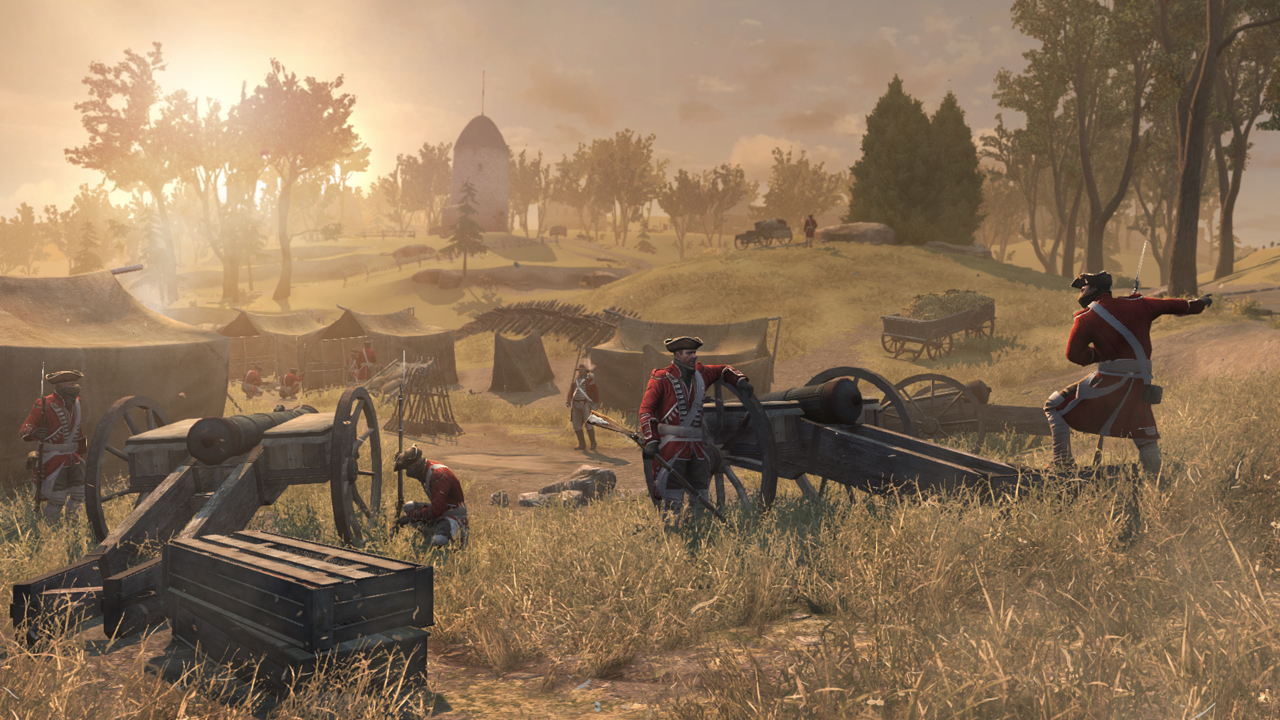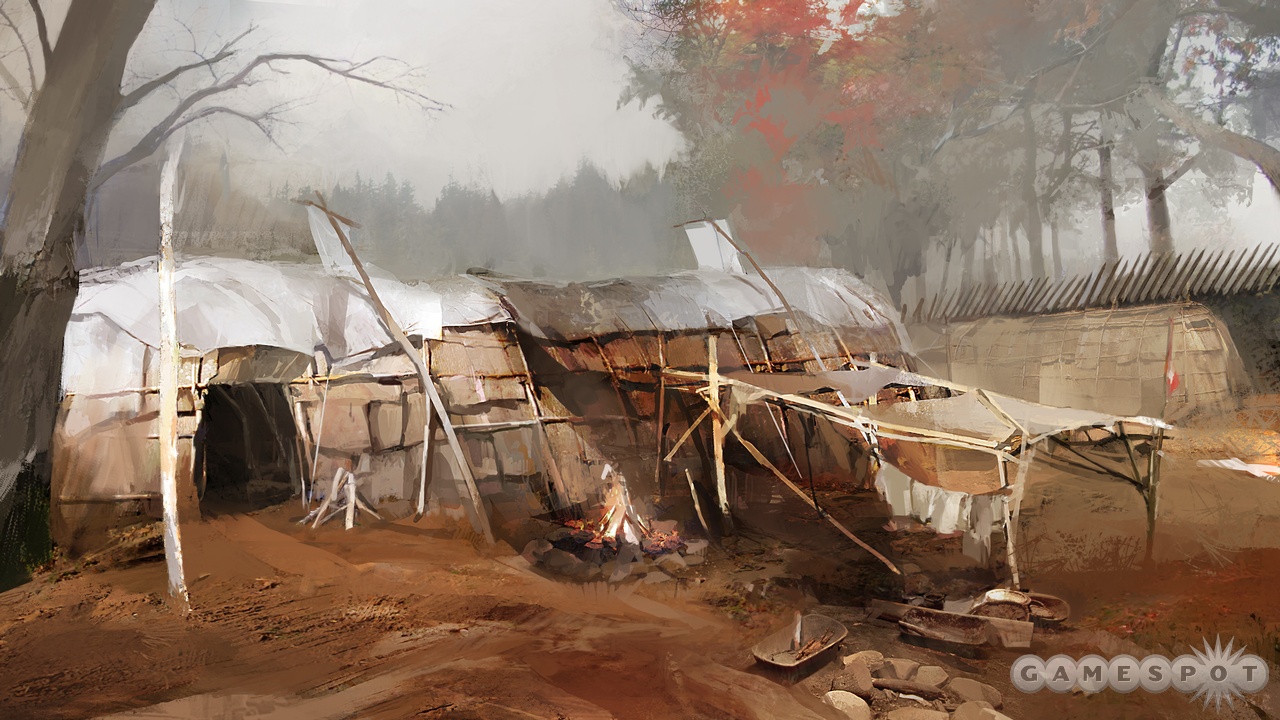Recreating Colonial America in Assassin's Creed III
We speak to creative director Alexander Hutchinson about the challenges of historical accuracy in the soon-to-be-released Assassin's Creed III.
Set during the American Revolution, Assassin's Creed III features a new protagonist with a mixed Native American-English heritage. Named Ratonhnhaké:ton but going by Connor, the hero of the game will inject himself into the ongoing struggle between the Templars and the Assassins.
But just how hard did Ubisoft have to work to faithfully recreate this period in time? How important is Native American culture to the game, and what did the development team do to ensure historical accuracy?
GameSpot called upon Assassin's Creed III creative director Alexander Hutchinson to find out.
We need to set the scene: what was it about the American Revolution that enticed you to use it as a backdrop for Assassin's Creed III, given that past games have already explored a myriad of culturally rich periods? What do you think characterises this period of history?
Half the fun of an Assassin's Creed game is being a tourist through different historical periods, so we're always looking for periods and places that are fresh for gamers. When the Renaissance was announced as the setting for Assassin's Creed II, a lot of people wondered how that would work in a game, and the same happened when we announced the setting for Assassin's Creed III. I was really pleased people were wondering how it could work when we announced, because that means we have some new fantasies to explore, and we can surprise people.
Once you decided on the American Revolution, what was the first step in the research process? Haul ass to the library, or watch a few hundred hours of History Channel documentaries?
All of the above! We spent around six months reading books, Wikipedia entries, watching documentaries, and building out huge flow charts to show where historical people were at any specific time, what they were trying to do or what their major concerns were, when and where big events occurred, all in the interest of finding those grey areas where we could insert our own fictional story.
We did a lot of research and ended up with a lot of unusual facts, such as Ben Franklin arguing that the turkey should be the national bird of America, not the thieving eagle that profits from the hard work of others, or his opinions on how to pick a mistress, or Washington’s fears about the outcome of the war. There's plenty of real, historical data that can present an interesting side to historical characters.
Tell me the story of how Thomas Deer, your Native American consultant on the game, came to be part of the team, and how his knowledge and experiences shaped the final product.
We've had a consultant on board for all the Assassin's Creed games as someone to present to us early on and inspire us, and then to help us fact check our history. This time, when we knew we wanted a First Nation hero, we realised that we needed to be very careful to be as accurate as possible, and not misrepresent anything or anyone. We wanted it to feel authentic in terms of art, clothing, language, everything. So we contacted the local communities, and once we convinced them we were earnest in our endeavours, they were very generous with their time. Mr Deer ran the cultural centre, so it was a perfect fit.
What was the most important thing that you learned from him, both as game developers and as human beings?
I think it's just how easy it is to fall back on clichés when dealing with cultures you only understand peripherally, and how careful you have to be: when designing Connor's village, we realised the cliché of tepees was far from the truth, and should be longhouses instead. We also changed all the jewellery that Connor or others wear to reflect accurate, period patterns, and much more. It was a huge amount of research and fact checking back and forth.
In terms of learning as a person, as an Anglophone living in Quebec, I work with a lot of French Canadians, and obviously while they speak English to me as my French isn't that great yet, when they’re speaking to each other, they immediately switch to French. After a while, it felt really artificial that in the scenes in the game where Connor is talking to another member of his tribe, that he'd be speaking English, so we went back and re-recorded whole sections of the game in the appropriate language. I think it's kind of magical to hear it, to feel really immersed in a culture most players have never seen before, let alone heard.
Where is Deer's influence seen in the game? What details did he correct, for example, and what details did he help you to add?
Clothing and jewellery were big fixes, language, and also he reinforced that it was a matriarchal society, so we made sure the elder in the village was a woman. There were also some cultural artefacts that we thought about using, such as masks, which he flat-out said would be offensive, so we cut them from the game and the story.
Did Deer have any concerns about Connor as a character, or his motivations?
I think he believed us when we said we were trying to be authentic, and when we hired Noah Watts to play him, who is also half Native American, he felt like we were making an honest attempt. In terms of characterisation, I think he was happiest that Connor was a fully rounded person, with good and bad aspects to his personality, who was involved in a story that wasn't just about being Native America; that was just the start of the story.
How confident are you that you avoided all the clichés and stereotypes of representing Native American heritage? Besides having a Native American as an adviser, did you take any other steps to get immersed in the culture?
We worked with local communities, visited them, went through the cultural centre and read a lot. Hopefully, we dodged any major gaffes, and the tone and feeling of the game is as earnest as we hoped.
How much does Connor connect with, and reflect, his Native American side? What aspects of his personality/actions show this to players? Is it his defining characteristic?
It is absolutely not his defining characteristic. He is half Native American, but this doesn't define his life. He's much more than that. He's as fully realised a character as we could possibly achieve. We give players a chance to see a huge chunk of his life, and hopefully you feel him grow and evolve over time.
How does the game pass on knowledge of this period to players? Is it simply about getting small details correct (names, locations), or does it run deeper than that (for example, Connor says a Native American prayer before he kills an animal)? Are these instances signposted? Or are they there for players to stumble upon?
We don’t want to wave a flag every time we insert an element we researched, especially as there’s so much of it in there. I think if we did our job, it just surrounds the player, so everything feels right: you feel like it’s a fully realised place, and not a cardboard cut-out. Around 80 percent of the speaking characters in the game are real people, so if we encourage a few people to look them up in the in-game database, and then maybe go online to read about the real person in more detail, then that would be amazing.
In the past, games haven't done a very good job of correctly representing cultural minorities. Why do you think this is? And what can game developers and studios do to pay more attention to this aspect?
I don't think there's anything particularly deliberate about it, especially as when the industry started, we were playing faceless characters or squares or the letter "P", but I think now that we're trying to be more progressive as an industry, I think more and more people will see the value and all the new stories you can tell by being more ambitious with your lead character.
On the whole, do you think video games are becoming better at helping players understand the world around them, and depicting aspects of that world that the medium might not have had the courage to tackle 10 years ago?
I think the industry is healthier than it’s ever been; you have games on phones, consoles, web browsers, dedicated handhelds, and you have everything from simple 2D games to huge, open-world 3D games, and every business model from pay once at $60 to free to play.
There is so much good content out there, but the business side is having a tough time tracking it all. And inside that, I think the next step is to be more courageous in terms of content and character. We’re definitely better than we were 10 years ago, when it wasn't even a discussion, but there’s a long way to go.
'Got a news tip or want to contact us directly? Email news@gamespot.com



Join the conversation